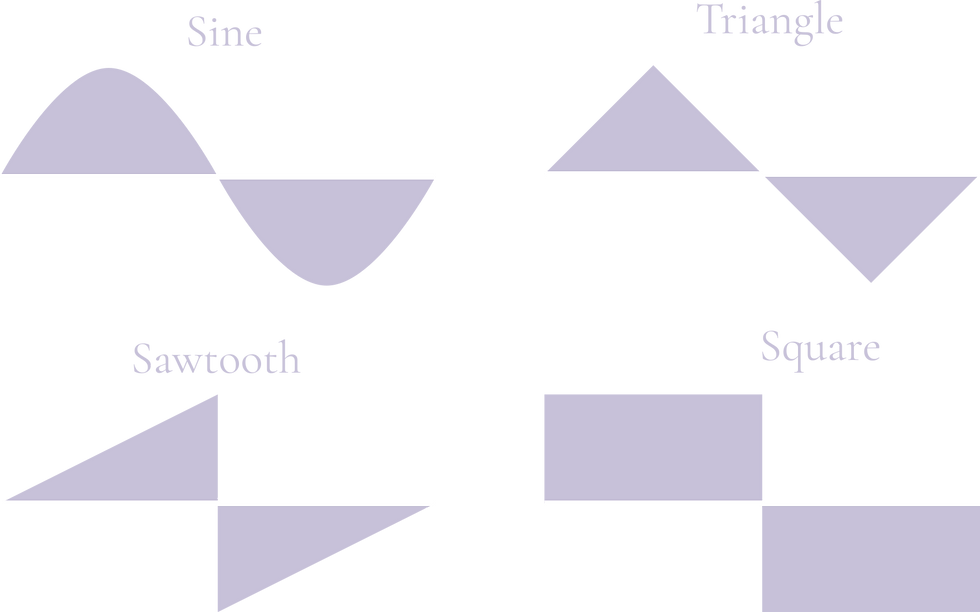Part I : Waves and Frequencies
- Ofélia S.

- Oct 31
- 3 min read
Table of content
Waves Properties Wave Mechanics
Frequencies
Waveforms
Before getting into the actual knob twisting fun, we need to understand what we are dealing with. So, let's start at the root, and work our way up,
Waves Properties
The fundamental unit we will be working from is the wave. And while it would be fascinating to get lost in the mathematics of a wave (which we might do in a future article), we will keep things simple and use a definition from which we can work:
A wave is a value that oscillates over time.
You will note that I am not talking about sound waves specifically, as we are going to be using many types of waves, all of which share the same characteristics:

1. The amplitude of a wave can be understood as the distance between its highest point and the resting state;
2. The wavelength is, unsurprisingly, the distance between two peaks or troughs of the wave, not to be confused with frequency or period;
3. The period is the time it takes for the wave to complete one full oscillation;
4. And the phase is the position of a point in time along the wave.
Let's delve into each of those in a bit more detail.
Wave Mechanics
Amplitude, if we take a sound wave as an example, would be the loudness: the range between zero and the highest value the wave reaches. Typically, amplitude is controlled through envelopes, which we will see later.
Wavelength is importantly related to frequency: the shorter the wavelength, the higher the frequency.
Period might sound redundant at first: on a pure sine wave like in the example above, period and wavelength are equal in length. It's important however to differentiate the two. Wavelength is the distance between two peaks, whereas the period is the time it takes for a point on the wave to come back to its original value: in the case of a sine wave, the period is one full rotation of the circle.
It would be difficult to overstate the importance of phase in sound synthesis. It is the bread and butter of FM synthesis. For this example, it's useful to imagine the phase as a point looping around on the track of the wave, following the shape and amplitude.
Importantly, phase is the reason for interferences, which are interactions between two or more waves. when two waves' phase are in sync, or 'in phase', they add up, which is called constructive interference. Conversely, two waves that are out of phase will interfere destructively, cancelling each other out.

Frequencies
Frequency is defined as the number of cycles per unit of time. To put it in plain English, frequency is the number of period by second, measured in Hertz (Hz).
1H is period by second.
Human hearing ranges from 20Hz to 20kHz (20,000Hz).
With the exception of pure sine waves, every waveform is constructed by stacking various frequencies together. The sound of a piano, guitar, bass, clown horn, what have you, nearly every sound is built from a range of frequencies of varying amplitudes, and it is one of the foundations of audio synthesis.
Speaking of stacking frequencies, you might have heard the concept of overtones, which are resonant frequencies, usually harmonics, above the fundamental frequency of a waveform. Overtones will give a sound a lot of its depth and texture.
Waveforms
The waveform is, to everyone's utter shock and bafflement, the form of a wave. While a waveform can have nearly any shape, there are four main ones that are used in sound synthesis:

Each of these will make a distinct sound, which you've likely heard before. Those shapes have become integral parts of the musical landscape as synthesisers rose in popularity, and most synths will be able to produce those by default. They are the building tools we are going to use throughout our synthesis journey.
And let's not forget one of the most useful tools we have: noise, to which I will dedicate an article. What you need to know is that noise is usually composed of all frequencies in hearing range to varying amplitudes,— you know, the noise of TV static or radios.
Conclusion
This is what constitutes a lot of the appeal of sound synthesis for me: those are relatively simple concepts, and once you wrap your head around them, the fun truly begins.

Comments